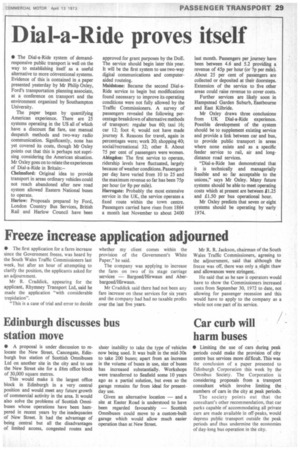Dial-a-Ride proves itself
Page 31

If you've noticed an error in this article please click here to report it so we can fix it.
• The Dial-a-Ride system of demandresponsive public transport is well on the way to establishing itself as a useful alternative to more conventional systems. Evidence of this is contained in a paper presented yesterday by Mr Philip Oxley, Ford's transportation planning associate, at a conference on transport and the environment organized by Southampton University.
The paper began by quantifying American experience. There are 25 systems operating in the US all of which have a discount flat fare, use manual despatch methods and two-way radio communication. Significantly, none has yet covered its costs, though Mr Oxley points out that this is perhaps not suprising considering the American situation. Mr Oxley goes on to relate theexperiences of Dial-a-Ride in Britain:—
Chelmsford: Original idea to provide transport in areas ordinary vehicles could not reach abandoned after new road system allowed Eastern National buses to operate.
Harlow: Proposals prepared by Ford, London Country Bus Services, British Rail and Harlow Council have been approved for grant purposes by the DoE. The service should begin later this year. It will be the first system to use two-way digital communications and computeraided routeing.
Maidstone: Became the second Dial-aRide service to begin but modifications found necessary to improve its operating conditions were not fully allowed by the Traffic Commissioners. A survey of passengers revealed the following percentage breakdown of alternative methods of transport: regular bus 60; taxi 16; car 12: foot 4; would not have made journey 8. Reasons for travel, again in percentages were; work 20; shopping 40; social/recreational 32; other 8. About 75 per cent of passengers were women. Abingdon: The first service to operate, ridership levels have fluctuated, largely because of weather conditions. Passengers per day have varied from 10 to 25 and the maximum revenue so far has been 75p per hour (or 8p per mile).
Harrogate: Probably the most extensive service in the UK, the service operates a fixed route within the town centre. Passengers carried have risen from 1864 a month last November to about 2400 last month. Passengers per journey have been between 4.6 and 5.2 providing a revenue of 45p per hour (or 7p per mile). About 25 per cent of passengers are collected or deposited at their doorsteps. Extension of the service to five other areas could raise revenue to cover costs.
Further services are likely soon in Hampstead Garden Suburb, Eastbourne and East Kilbride.
Mr Oxley draws three conclusions from UK Dial-a-Ride experience. Possible development of the system should be to supplement existing service and provide a link between car and bus, to provide public transport in areas where none exists and as a specific feeder service to rail, air and longdistance road services.
"Dial-a-Ride has demonstrated that it is technically and managerially feasible and so far acceptable to the unions," says Mr Oxley. Many future systems should be able to meet operating costs which at present are between 11.25 and £1.50 per bus operational hour.
Mr Oxley predicts that seven or eight systems should be operating by early 1974.
























































































































